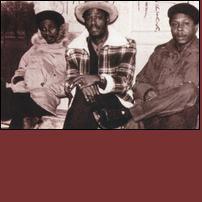
The Heptones
by Steve HueyOne of the definitive rocksteady vocal groups, the Heptones were also one of the few to successfully make the transition to the reggae era. The group was fronted by Leroy Sibbles, who was not only an exquisite singer but also a talented songwriter, arranger, and session bassist at the legendary Studio One. Penning much of its own material, the group boasted one of the deepest catalogs of its time, full of high-quality numbers that were widely imitated for their close-harmony vocals, and widely recycled for their loose, liquid, melodic instrumental grooves. The Heptones were formed in Kingston in 1965, with a lineup of Sibbles, Barry Llewellyn, and Earl Morgan. At first they called themselves the Hep Ones, but a one-word name seemed to make more sense to fans, and the change was made accordingly. They made their first recording for Ken Lacks Caltone label that year, a strange ska adaptation of The William Tell Overture titled Gun Men Coming to Town.Things started to take off for the group in 1966 when they caught on at Clement Coxsone Dodds Studio One, the pre-eminent hit factory of the rocksteady era. Dodd helped train the group in the art of harmony singing, and also guided budding songwriter Sibbles, who developed a sly, sarcastic sense of humor to underpin his tales of broken-hearted lovers. The Heptones had their first hit later that year with Fattie Fattie, a ribald paean to large women that was banned from Jamaican radio but sold briskly nonetheless. They went on to record vast amounts of material for Dodd over the next five years, including their first-ever LP, On Top, in 1970. As the hits piled up, Sibbles became a staff songwriter and arranger, played bass with the Studio One house band on a multitude of recordings, and worked as an assistant producer and talent scout as well. However, by 1971, a Rastafarian social consciousness was emerging in his writing, and he had grown tired of the boundaries of working in Dodds studio system; that sense of confinement led to an acrimonious split with Dodd.Over the next few years, Sibbles took the Heptones on a virtual tour of Jamaicas top producers, cutting material for Joe Gibbs, Harry J, Augustus Pablo, Rupie Edwards, and many others. In 1973, they moved briefly to Canada, but soon returned to Jamaica. The Heptones signed a major-label deal with Island in 1975 and released their label debut, Night Food, the following year; it was produced by Lee Scratch Perry and featured mostly new versions of old Studio One material. The follow-up, 1977s Party Time, followed a similar blueprint, and also included an eye-opening cover of Bob Dylans I Shall Be Released. It proved to be the groups biggest-selling album in the international market, but the 1978 follow-up, Better Days, sold disappointingly by comparison, and Sibbles departed for a solo career not long after.The remaining Heptones replaced him with Naggo Morris and soldiered on with 1979s Joseph Hoo Kim-produced Good Life. They continued to record and perform during the 80s, though without the success they had enjoyed with Sibbles out front; gradually, other members drifted through the ranks, including Glen Adams and Joseph Forester. The original trio of Sibbles, Llewellyn, and Morgan finally reunited in 1995 for the album Pressure!, produced by Tappa Zukie.
